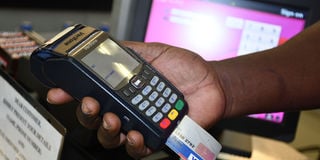There’s more opportunity in the payments space

A man completes a cashless transaction. Several factors are driving the push towards cashless economies. PHOTO/ Edgar R. Batte
What you need to know:
Expanding access to mobile money or online banking remains an opportunity for the payments industry to evolve further.
Growth in electronic payments (mobile money and Real Time Gross Settlement [RTGS]) transfers recovered strongly in 2020 and 2021, at 18 percent and 26 percent respectively, after sluggish growth of 12 percent in 2018 and 6 percent in 2019. This recovery is due to the impact of restrictions during Covid-19 related lockdowns as well as legal/ regulatory reforms aimed at reducing the dependence on cash in the Ugandan economy. The reforms include the National Payments Systems Act 2020 through which Bank of Uganda (BoU) had issued 17 payments system related licences as of 1 August 2022 and increasing the scope for electronic payments.
In 2017, Government of Uganda estimated that to BoU, 80 percent of payments were cash-based whereas the World Bank reported that only 33% of Ugandans had access to a bank or other financial institution account. With RTGS and mobile money payments for 2017 recorded at Shs400 trillion by Bank of Uganda, this left cash transactions of at least Shs1,600 trillion. There are several factors driving the push towards cashless economies around the world, which include:
1. It costs a lot of money to print new money and to replace it when it’s worn out.
2. Cash needs to be physically moved around, sometimes by air, which is expensive and vulnerable to theft.
3. It is very difficult to trace paper notes obtained or deployed by criminals or terrorists.
4. Handling and transacting in cash is very slow.
These and other factors are driving the push towards cashless economies around the world.
So what are the opportunities for evolution of payments?
Broadly, there are two sets of changes: evolutionary changes which improve what we are currently doing through technology enabled innovations; and revolutionary changes that introduce new ways of making payments. The goals are similar - driving towards faster, safer and cheaper payments.
Here, we focus on evolutionary changes for which we have already seen amazing innovations like cards, RTGS and EFT which essentially digitised existing payments activities, drastically reducing processing time and costs.
This has provided convenience, speed and reduced cost. Similar benefits are afforded by mobile money which has the added advantage that users don’t need bank accounts in order to make payments to individuals, businesses and government bodies.
However, there remains scope for further evolution of current electronic payments, including:
Operations
Micro deposit-taking institutions (MDIs) are prohibited from offering debit cards or online banking facilities. A prudent approach, perhaps leverage the sandbox window, will go a long way in expanding coverage of electronic payments.
In addition, usage of debit and credit cards remains very low in Uganda and some retailers are reluctant to accept cards on account of related costs.
Whereas availability of mobile money payments has grown exponentially, there are too many businesses for which this option is not available.
Expanding access to mobile money or online banking remains an opportunity for the payments industry to evolve further.
Cross-border capability
Through innovation and collaboration, interbank payments have been digitised across East Africa and Comesa.
However, beyond that, banks still rely on SWIFT for funds transfers which take two days and are limited to countries where supporting bank-to-bank correspondent relationships exist.
This restricts trading opportunities with countries without such relationships. Similar limitations apply to mobile money payments which are scarcely available across borders.
Fintechs have already targeted this space but are currently constrained by the need for licensing in multiple countries. More work is required to integrate both bank and mobile payment systems, particularly on the African continent.
Security
In Uganda, mobile money has been targeted by criminal networks and more needs to be done by security agencies to investigate SIM fraud schemes.
Electronic payments are more secure than cash because of the higher levels of traceability but they are also vulnerable to cyber fraud and other financial crimes.
Kenyan banks have frozen accounts for two prominent African Fintech companies on suspicion of money laundering activity. This highlights the need for levels of client due diligence and transaction monitoring akin to those in the banking industry,
Cost
Mobile money has brought down transaction costs in many cases, particularly for long-distance payments, school fees, etc. However, transaction costs and related taxes at certain levels tilt the balance for many transactions in favour of cash.
Mobile money also enabled many businesses to close cash offices thereby reducing costs, however these costs have not been demonstrably passed down to consumers.
Accordingly, further innovation is required to maintain competitiveness of mobile money compared to cash transactions and to improve fairness or the perception of it. There is also scope to reduce the tax rates on mobile money as clearly the growth in volumes will more than compensate for lost tax revenue.
In conclusion, whilst great strides have been made in reducing Uganda’s dependence on cash, scope exists for deepening and widening electronic payments to reduce cash payments.
Getting this work done will require innovation by payments service providers and government through improved regulation, enforcement of existing criminal laws and continued behavioural change by businesses and the wider public.
The writer is the country senior partner of PwC Uganda.




